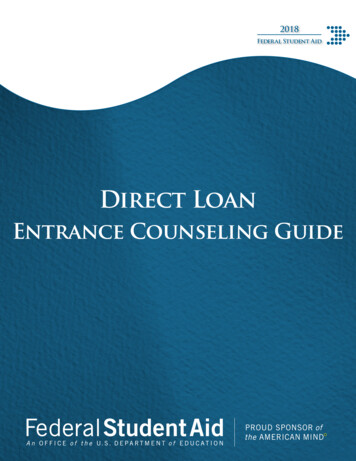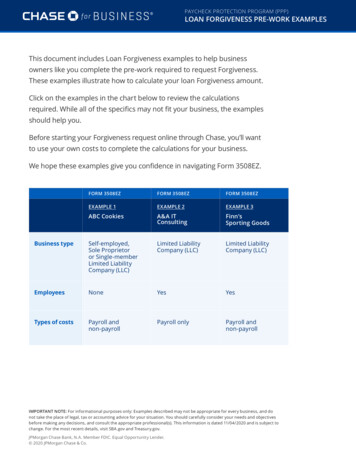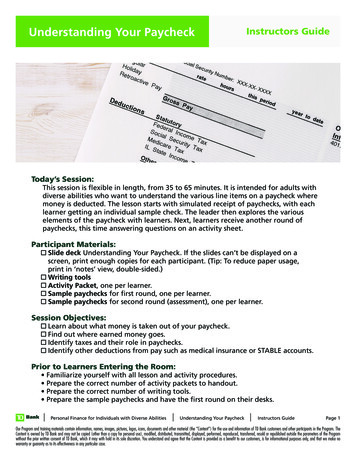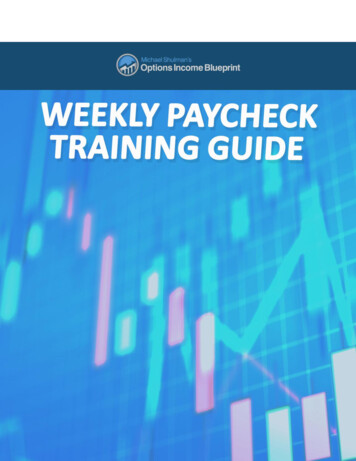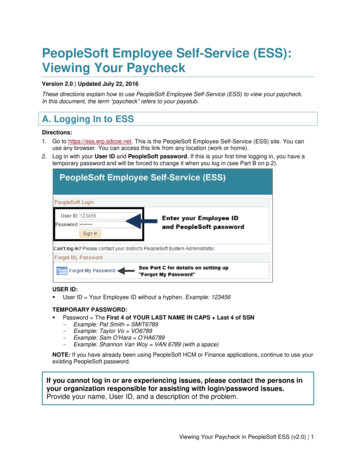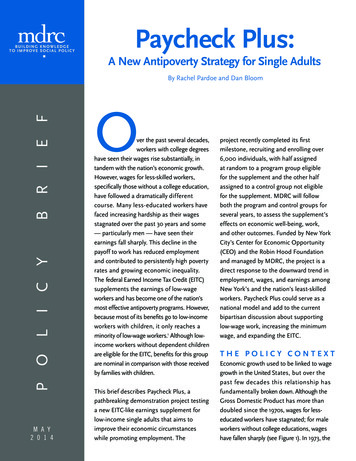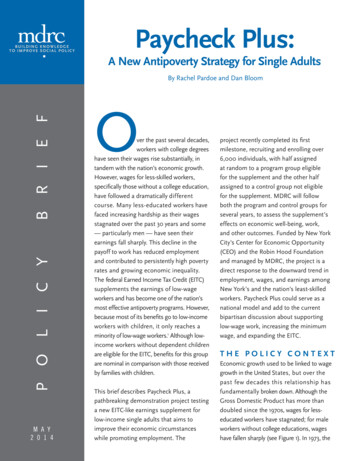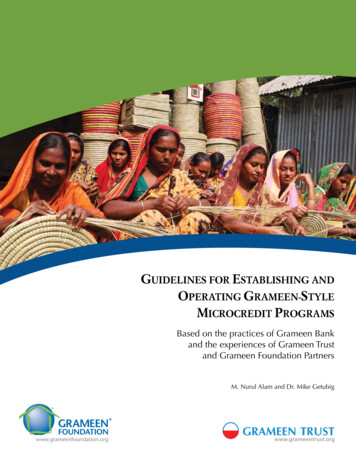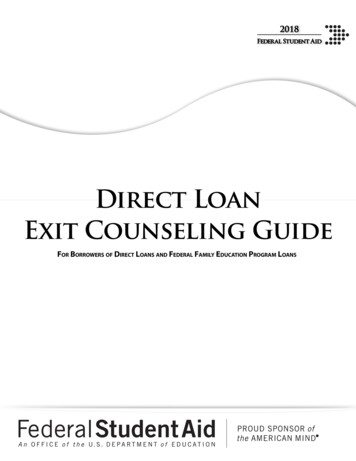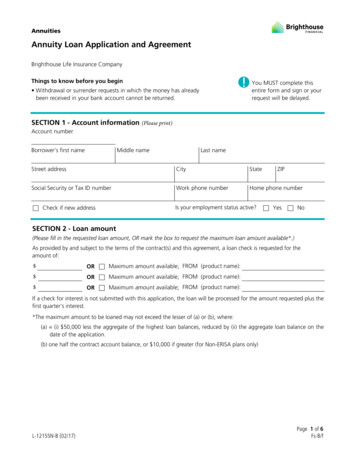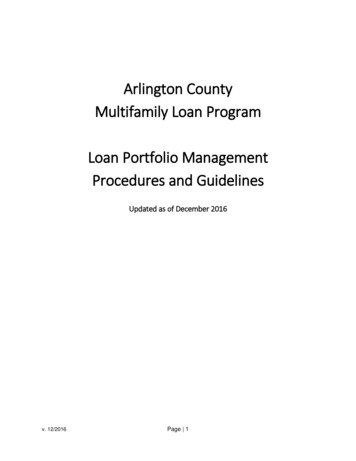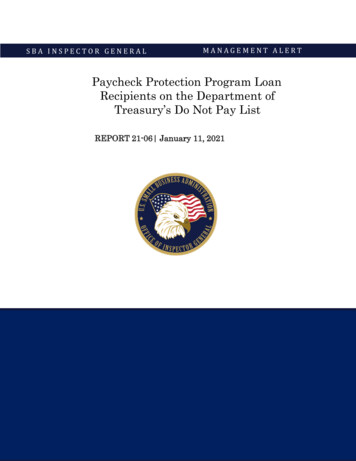
Transcription
SBA INSPECTOR GENERALMANAGEMENT ALERTPaycheck Protection Program LoanRecipients on the Department ofTreasury’s Do Not Pay ListREPORT 21-06 January 11, 2021SBAINSPECTORGENERALMANAGEMENTALE
Office of Inspector GeneralU.S. Small Business ry 11, 2021Jovita CarranzaAdministratorHannibal “Mike” Ware /S/Inspector GeneralPaycheck Protection Program Loan Recipients on the Department of Treasury’s DoNot Pay ListThe Office of Inspector General (OIG) is issuing this Management Alert to bring to your attentionserious concerns about improper payments to lenders for potentially ineligible recipients of loansunder SBA’s Paycheck Protection Program (PPP) in response to the Coronavirus Disease 2019(COVID-19) pandemic. This issue requires immediate attention and action.Due to complaints of fraud received by the OIG, we collaborated with the U.S. Department of theTreasury (Treasury) Do Not Pay (DNP) Business Center, which identified high-risk transactionsrelated to financial assistance to small businesses for the COVID-19 pandemic. Our review ofTreasury’s analysis showed approximately 3.6 billion in PPP loans to potentially ineligiblerecipients.Expedited management action could reduce or prevent the potential for loss in terms of the risk ofimproper payments to lenders for amounts ineligible for forgiveness as well as any fees. OIGcommunicated summary results to SBA management, who requested Treasury’s results and havesystemically put a “hold” flag on loans identified by the DNP team to ensure the loan applications areproperly reviewed before processing for forgiveness or any further disbursements. Additionally, SBAmanagement contacted the DNP Business Center and discussed the matching parameters to ensurethat DNP’s results were consistent with PPP eligibility provisions. Consequently, DNP’s results wererevised and are represented in this memorandum.BackgroundTreasury’s DNP Working System is the source of centralized data and analytic services that verifieseligibility and helps agencies identify and prevent the fraud, waste, and abuse associated withimproper payments. Treasury’s system is designated by the Office of Management and Budget (OMB)and mandated by the Payment Integrity Information Act of 2019 dated January3, 2020 (See AppendixI.) The Treasury DNP system gives agencies a higher degree of certainty that a payee is legitimate andeligible before making an award or payment.The law requires agencies to evaluate fraud risks and use a risk-based approach to design andimplement financial and administrative controls to counter identified fraud risks. The law reinforcesthe requirement for agencies to review prepayment and pre-award procedures. Agencies are also2
required to thoroughly review available databases with relevant information to determine programor award eligibility and prevent improper payments before the release of any federal funds. At aminimum and before issuing any payment or award, agencies must review certain databases to verifyeligibility of the payment and award.The law also requires agencies to review and identify programs susceptible to significant improperpayments, report on the amount and causes of improper payments, and develop plans for reducingimproper payments. An improper payment is any federal government payment made to an ineligiblerecipient or for an ineligible good or service, duplicate payment, or payment for goods or services notreceived (except for such payment authorized by law).The President signed the Coronavirus Aid, Relief, and Economic Security Act (CARES Act) on March27, 2020, and the Paycheck Protection Program and Health Care Enhancement Act on April 24, 2020.The laws authorize up to 659 billion for the PPP to provide small businesses with the resources theyneeded to maintain their payroll, hire back employees who may have been laid off, and coverapplicable overhead during the pandemic.The CARES Act requires eligible borrowers to make a good faith certification that the loan is necessary due to the uncertainty of current economic conditions caused byCOVID-19;they will use the funds to retain workers and maintain payroll, lease, and utilitypayments; andthey are not receiving duplicate funds for the same uses from another SBA program.The CARES Act also provides eligible recipients forgiveness of indebtedness on a covered PPP loan inan amount equal to the sum of certain costs and payments made during the covered period.Borrowers apply to lenders for forgiveness on PPP loans. However, SBA may refuse guarantee for anyportion of a loan ineligible for forgiveness.OIG’s preliminary review and investigative findings have identified concerns with internal controlsand red flag indicators of fraud in the PPP. OIG has already initiated a robust plan to oversee SBA’sresponse to COVID-19. Our investigative staff has also begun hundreds of investigations intosuspected PPP fraud.Role of DNP in SBA’s Initial COVID-19 PPP ResponseQuerying PPP borrower identifiers to data maintained in the DNP portal can identify potentiallyineligible loan applicants. SBA OIG provided PPP loan data to Treasury’s DNP team that used SBAbusiness rules for PPP eligibility to analyze the data. As of August 8, 2020, after cancellations, SBA hadapproved 5.2 million PPP loans totaling 525 billion. To be eligible to receive federal assistance suchas a PPP loan, a business must not have any current federal debarments or suspensions. Additionally,a borrower must not have delinquent federal loans or have defaulted on any federal loans to receivefederal financial assistance.Loans to Ineligible RecipientsTreasury’s DNP analysis found: Of the 525 billion in total approved PPP loans, 57,473, or 1.1 percent, matched a DNP datasource record, indicating loan ineligibility. The 57,473 matched loans totaledapproximately 3.6 billion; 280 million was undisbursed as of August 8, 2020. (See Table1).Just 10 of the 3,403 loan servicing location identifications accounted for 49 percent of thematched loans and 28 percent of the total matched loan value.3
To determine if PPP loans were made to eligible loan recipients, the Treasury team merged the datatables OIG supplied, extracted all loan applications that were fully cancelled, and matched PPPborrower identifiers to data in the DNP portal. The DNP portal accesses multiple federal data sourcesrequired by law and includes Treasury Offset Program (TOP Debt Check)Credit Alert Interactive Verification Reporting System (CAIVRS)System for Award Management (SAM Exclusion),Social Security Administration’s Death Master File (DMF),American InfoSource (AIS Obituary and AIS Probate),Department of Defense and the Department of State records of deceased persons (SeeAppendix II)Each data source offers different levels of “match strength,” contingent on the data elements includedin the data source. Treasury’s DNP portal identifies three types of match strength: conclusive,probable, and possible. Data sources with conclusive matches provide the optimal matching results.Conclusive matches represent a 100 percent match in a federal data source(s) to a recipient’spersonal identifiers and are least likely to yield a false positive result.Conclusive matches compare data elements, including name and Taxpayer Identification Number (TIN)Employer Identification NumberData Universal Numbering SystemSocial Security NumberAddressTreasury’s analysis matched 38,823, or 67.6 percent, of the 57,473 loans by “Exact TIN plus Name,”and the matches were deemed conclusive.Table 1. Numbers of Matched Loans by Match Types (Distinct Loans)Match TypeExact TIN*and NameExact TINExact TIN and Non-ExactNameExact TIN and Name, ExactTIN and Non-Exact NameExact TIN, Exact TIN andNameExact TIN, Exact TIN andNon-Exact NameExact TIN, Exact TIN andName, Exact TIN and NonExact NameTotalMatchedLoansMatched LoanCurrent LoanAmount (s)MatchedLoans(%)Matched CurrentLoan Amount (%)35,93614,574 1,915,166,634.67 1,067,742,615.4762.53%25.36%53.36%29.75%1,578 101,613,230.292.75%2.83%3,9161,2431606657,473*TIN stands for Taxpayer Identification Number 435,615,342.22 61,122,130.96 5,164,220.81 2,968,124.75 4%0.08%We believe the identified PPP loans were made to potentially ineligible recipients because SBA and itslenders relied on applicants’ self-certification for PPP loan eligibility. For example, applicants were4
required to certify that the business did not have any current federal debarments or suspensions andthe borrower(s) did not have delinquent federal loans or have defaulted on any federal loans.ConclusionSBA should take immediate action to limit improper payments by strengthening existing controls andimplementing additional internal controls to address improper payments, especially through theutilization of existing resources.Treasury’s analysis of potentially ineligible recipients demonstrates the importance of front-endcontrols and careful review by SBA of the loans identified. Our preliminary review of Treasury’sanalytical summaries indicates SBA should reassess controls to ensure only eligible recipientsobtained PPP loans and prevent improper payments, as required by the law. To prevent improperpayments, SBA will need to implement strong controls to ensure that loans to ineligible recipients arenot forgiven and any undisbursed funds are not released to borrowers.RecommendationsTo establish more effective oversight controls related to the PPP for COVID-19 pandemic relief, werecommend that the Administrator direct the Associate Administrator for the Office of Capital Accessto:1) Promptly identify PPP loans that have not been fully disbursed and follow-up with thelenders to stop 280 million in potential improper loan disbursements.2) Strengthen SBA controls to ensure that loans to ineligible recipients are not forgiven.3) Review prepayment and pre-award procedures and work with Treasury to formulatea technical approach to use Treasury’s DNP portal to determine loan applicanteligibility and prevent improper payments before the release of any federal funds.Analysis of Agency CommentsSBA leadership provided formal comments to this Management Alert, included in Appendix III. In thecomments, the agency states, “Prior to the Management Alert, SBA developed systems to screenpotential borrowers against the Treasury Department's Do Not Pay List. These efforts were underwayas a part of the loan review process before OIG issued the Management Alert.”However, we believe this response does not acknowledge the importance of and need for therecommended actions. In August 2020, after completing our fieldwork, we briefed agency managerson the significance of the DNP audit results and the immediate need to put systematic screeningmechanisms in place. During the briefing, we emphasized that SBA should engage with Treasury’sDNP program promptly and begin taking steps to establish screening processes.After the briefing, agency managers requested--and we provided--the preliminary results of theTreasury DNP data analysis. We expected SBA managers would begin implementing the necessaryscreening protocols shortly after reviewing the analysis we provided.However, SBA management later used the analysis results only to highlight potential PPP loanexceptions through use of “hold” flags in the Capital Access Financial System—alerts that indicate theneed for further review of potential improper payments. We also understand that the agency plans touse that information in loan forgiveness reviews. We agree it is appropriate for the agency to use ourDNP analysis for the loan forgiveness process.However, management’s assertion that “SBA developed systems to screen potential borrowersagainst the Treasury Department's Do Not Pay List” before our alert does not match OIG’s or5
Treasury’s understanding of the timeline of events. Management’s comments indicate preventativecontrols have already been put in place. But our understanding from Treasury is that portal access toDNP is being established for two users, and batch processing capability for high-volume activity is stillunder development. Batch processing to the DNP portal will be critical for SBA to implement OIGrecommendations without slowing PPP loan processing.Management did not specifically address our individual recommendations in its response. However,the statement that “efforts are underway” suggests that management agrees with ourrecommendations. We will continue to work with SBA management to resolve the recommendations.The following summary clarifies the necessary remediation actions to close our recommendations:1) Promptly identify PPP loans that have not been fully disbursed and follow-up with thelenders to stop 280 million in potential improper loan disbursements. Thisrecommendation can be closed when management provides documentation indicating allundisbursed PPP loans identified as potential improper payments have been reviewed andprocessed.2) Strengthen SBA controls to ensure that loans to ineligible recipients are not forgiven.This recommendation can be closed when the agency develops policy and establishes staffguidance to prevent approvals of loan forgiveness if the recipient was ineligible for a PPP loanunder federal criteria.3) Review prepayment and preaward procedures and work with Treasury to formulate atechnical approach to use Treasury’s DNP portal to determine loan applicant eligibilityand prevent improper payment of any federal funds. This recommendation can be closedwhen the agency provides evidence that functioning controls are in place to compare PPPapplicant data against DNP portal data to prevent ineligible applicants from receiving federalassistance.We prepared this Management Alert in alignment with OIG’s quality control standards and theCouncil of Inspectors General for Integrity and Efficiency’s (CIGIE) Quality Standards for federalOffices of Inspector General, which require that we conduct our work with integrity, objectivity, andindependence. In connection with this Management Alert, we reviewed Treasury’s results and relateddocumentation and interviewed Treasury representatives.If you have any questions, please contact me or Andrea Deadwyler, Assistant Inspector General forAudits, at (202) 205-6586.cc:William Manger, Chief of Staff and Associate Administrator, Office of Capital AccessChristopher Gray, Deputy Chief of StaffJohn A. Miller, Deputy Associate Administrator, Office of Capital AccessSteve Kucharski, Director, Office of Performance and Systems ManagementJihoon Kim, Director, Office of Financial Program OperationsBrittany Biles, General CounselMartin Conrey, Attorney Advisor, Legislation and AppropriationMichael Simmons, Attorney Advisor, Office of General CounselTonia Butler, Director, Office of Internal ControlsRafaela Monchek, Director, Office of Continuous Operations and Risk ManagementTami Perriello, Chief Financial Officer and Policy Advisor to the Administrator6
Appendix I. Data Sources Mandated by Law and Used in Treasury’s PPPAnalysisTreasury matched PPP borrower identifiers to data maintained in the following data sources:Treasury Offset Program (TOP Debt Check) TOP Debt Check is a data extract or subset of data contained in the TOP delinquent debtordatabase. It was created for the Treasury DNP system to help agencies fulfill the obligation todeny federal loans, loan insurance, and loan guarantees to people who are delinquent onfederal nontax debts and child support obligations (if allowed by agency statute andregulations).DNP receives weekly TOP Debt Check updates.Credit Alert Interactive Verification Reporting System (CAIVRS) A shared database of defaulted federal debtors, CAIVRS enables processors of applications forfederal credit benefits to identify individuals who are in default or have had claims paid ondirect or guaranteed federal loans or are delinquent on other debts owed to federal agencies.Treasury DNP receives CAIVRS data from the following agencies:o U.S. Department of Justiceo U.S. Department of Agricultureo U.S. Department of Veterans Affairs (Database not open to states)o U.S. Department of Housing and Urban Developmento Small Business AdministrationThe entire CAIVRS database is refreshed each time any agency source forwards an update.The agency sources update data at various times throughout the month.System for Award Management (SAM Exclusion) SAM Exclusion records contain the data for all active exclusion records entered by the federalgovernment identifying those parties excluded from receiving federal contracts, certainsubcontracts, and federal financial and nonfinancial assistance and benefits.Treasury DNP receives daily SAM updates.Death Master File (DMF) The DMF from the Social Security Administration (SSA) is a data source that contains morethan 94 million records. The file is built from internal SSA records of deceased personspossessing social security numbers and whose deaths were reported to the SSA.DNP uses the public DMF but does not have access to the full DMF. Legislation such as theSocial Security Act precludes the sharing of the full DMF with agencies that do not paybenefits.DNP receives a weekly update to the public DMF and full refresh every quarter.American InfoSource (AIS Obituary and AIS Probate) AIS is a commercial global financial services company that provides obituary and probatedeath data. AIS death data includes information about deceased individuals from all 50 states.AIS gathers information from probate court records and published obituaries. Obituaries aregathered by AIS from more than 3,000 funeral homes and thousands of newspapers. Probaterecords are collected from county courts.DNP receives weekly updates of all AIS data.7
Department of Defense (DOD) DOD death data provides information about confirmed or presumed deaths of United Statesmilitary members while abroad and at home.DNP receives an update to DOD data the first week of every month.Department of State (DOS) DOS death data provides information about confirmed or presumed deaths of United Statescitizens while abroad. Data is provided by DOS’s Bureau of Consular Affairs and originatesfrom the American Citizen Services System.DNP receives an update to DOS data on the 11th of each month.Table 2 summarizes Treasury’s matched loans by the DNP data source(s).Table 2. Matched Loans by DNP Matched Data Source(s)Match SourceTOP Debt CheckCAIVRS (TIN Only)SAM ExclusionAIS ObituaryDMFAIS ProbateDept. of vedAmount ( ) 1,565,193,095.40 1,145,296,385.40 73,627,495.19 826,654,548.31 178,314,957.36 49,916,171.00 2,720,320.50Current Amount( ) 1,554,269,548.20 1,136,997,092.00 73,684,412.26 825,395,032.02 179,104,890.06 49,588,488.24 2,720,320.50UndisbursedAmount ( ) 196,605,444.84 74,077,133.31 5,478,728.36 12,609,669.41 2,771,773.16 32,500.00 0.00Note: The count of matched loans will not equal the 57,473 loan total seen in Table 1, “Numbers of Matched Loans byMatch Types (Distinct Loans),” because some loans matched multiple data sources. If the same loan matched to multiplesources, its amount is included in the totals for each matched source.8
Appendix II. Treasury’s Analytic ExplanationsPPP Loan UniverseThe SBA Office of the Inspector General provided the data to DNP by on August 11, 2020. The datafiles represent the universe of SBA PPP loans at the time of data extraction on August 8, 2020.There is a difference of less than 0.1 percent between the total value and total count of loans screenedby DNP compared to reported figures from SBA. 1 This difference could be attributed to the date andtime the file was extracted by SBA for analysis. The SBA analysis was produced using finalized datathrough August 8, 2020. The file DNP received was extracted before the final updates but before theclose of business on August 8, 2020.Data Cleansing and Standardization ProcessTreasury DNP discovered special characters (non-ASCII) in the SBA data. These characters caused anissue with the DNP data loading process and required cleansing before the data could be loaded. Afterthe non-ASCII characters were removed from the files, the data loaded successfully. Because somecharacters were removed from the analyzed fields, the matching strategy was changed from exactTIN and name matches to exact TIN and nonexact name using similarity scoring, as follows.Jaro-Winkler: Calculates the edit distance between two strings, giving a more favorable rating tostrings that begin with the same character.Levenshtein: Calculates the edit distance between two strings. Each difference is counted to providethe score.Spedis: Computes the cost of converting one text string to another. Each operation is assigned a cost,the cost is summed up at the end of the string comparison to produce a score.Spedis-SoundEx: Each string is converted into a SoundEx value based on the sound certain lettercombinations may create. The SoundEx string is then run through the Spedis similarity function.To assist in the name matching process, name fields in the SBA data were standardized using thesame standardization process used to standardize the name fields in the DNP data sources.Findings AnalysisLoans with a status of "Fully Cancelled" were removed from data, because they included duplicateloan applications and loans that were not approved.A loan record may have multiple matches because all loan records have multiple TIN and name fields.The borrower's TIN is used in conjunction with the borrower's name and the borrower's businessname. The principal's TIN is used in conjunction with the principal's name. There is also a possibilitythat a TIN and name match could be present in multiple data sources.Loans matched to the CAIVRS data source are TIN only matches. CAIVRS does not have nameinformation.DNP Data Source Dictionary of VariablesDNP Match Source: Name of the data source in which a loan had an “Exact TIN” (CAIVRS only),“Exact TIN and Name,” or “Exact TIN and Nonexact Name” match.1Small Business Administration, “Additional Program Information: Summary of Cumulative Paycheck Protection Programdata as of 11:59 PM EDT, Aug 8, 2020.” at irus-reliefoptions/paycheck-protection-program. Accessed by DNP on August 20, 2020.9
Match Type: Matches were produced by “Exact TIN” (CAIVRS only), “Exact TIN and Name,” or “ExactTIN and Nonexact Name.”Matching Field: All matches are matched using the exact TIN. This field identifies which name fieldcontained the name that matched a DNP data source. In the case of CAIVRS, this field identifies thematching TIN field. The defined values are as follows: Borrower TIN and Borrower Name equal Borrower TIN and Borrower Name matchBorrower TIN and Business Name equal Borrower TIN and Borrower Business NamematchPrincipal TIN & Principal Name equal Principal TIN and Principal Name matchBorrower TIN equals Borrower TIN only match (CAIVRS)Borrower Business TIN equals Borrower TIN only match (CAIVRS)Principal TIN equals Principal TIN only match (CAIVRS)CAIVRS Reporting Agency: The name of the agency whose CAIVRS feed contained the matchedrecord.Name from DNP Match Source: The name as listed from the DNP matched data source.Record Effective Date: The date the matched record became active in the DNP data source.Record End Date: The date the record became inactive in the DNP data source. Inactive records mayindicate the entity is no longer on a particular list or that the record was replaced with an updatedrecord when information changed. In this case, there may be a match to both the INACTIVE andACTIVE records.Record Status: Identifies if the record was ACTIVE or INACTIVE at the time of the analysis.Date of Death: The date reported in the DNP death data sources as the date when an individualpassed away.DNP Data Source List Status Code: A brief description of why an entity is listed on a DNP datasource.10
Appendix III. Management’s CommentsSBA’s Response to the AlertU.S. Small Business AdministrationWashington, D.C. 20416OFFICE OF THE ADMINISTRATORJanuary 4, 2021The Honorable Hannibal "Mike" WareInspector GeneralU.S. Small Business Administration409 3rd Street, SWWashington, DC 20416Dear Inspector General Ware:I write in response to the Office of lnspector General's ("OIG") November 30, 2020 ManagementAlert on Paycheck Protection Program (PPP) loan recipients on the Department of Treasury's DoNot Pay list.Prior to the Management Alert, SBA developed systems to screen potential borrowers against theTreasury Department's Do Not Pay List. These efforts were underway as a part of the loan reviewprocess before OIG issued the Management Alert. In addition, when SBA resumes PPP lendingpursuant to the Economic Aid to Hard-Hit Small Businesses, Nonprofits, and Venues Act, everynew PPP loan application submitted to SBA for processing by a lender will be searched against theTreasury Department's Do Not Pay list.SBA is working to protect taxpayer dollars and ensure that the Paycheck ProtectionProgram benefits only eligible borrowers. I would be happy to further discuss our responseregarding the Do Not Pay list and to provide further assistance to your office.Sincerely,/s/Jovita CarranzaAdministrator11
The Office of Inspector General (OIG) is issuing this Management Alert to bring to your attention serious concerns about improper payments to lenders for potentially ineligible recipients of loans under SBA's Paycheck Protection Program (PPP) in response to the Coronavirus Disease 2019 (COVID-19) pandemic.
